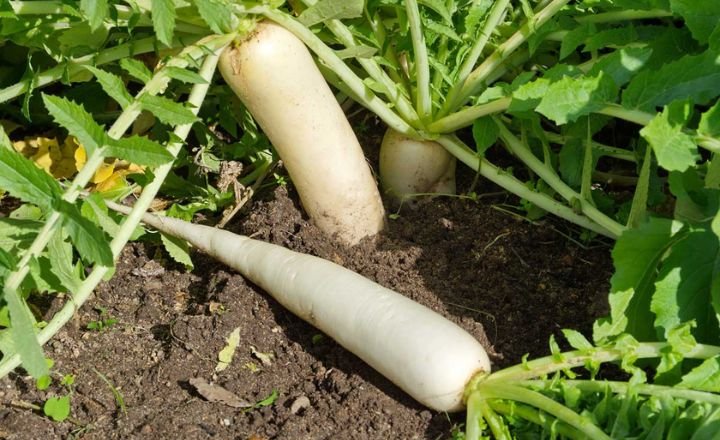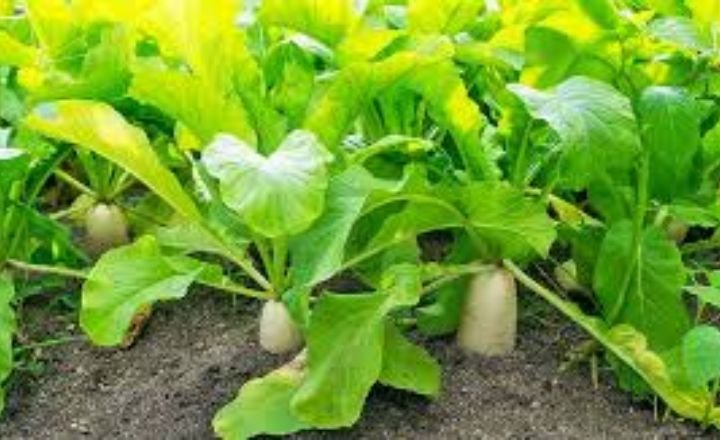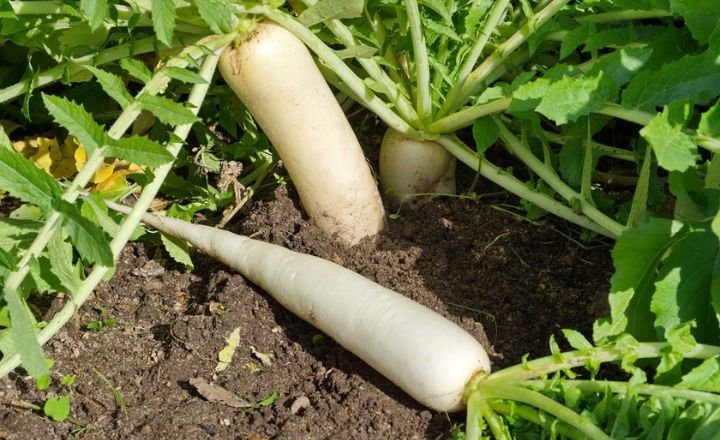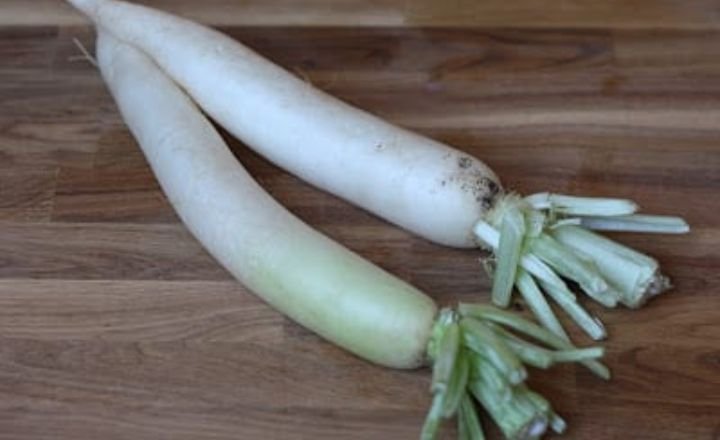The biting into a crisp, refreshing salad that dances with flavors and adds a delightful crunch to your dishes. The heart of this culinary experience lies the Grow Daikon Radisha versatile root vegetable celebrated not only for its vibrant taste but also for its impressive health benefits.
Originating from East Asia, the daikon has gained popularity all over the world, becoming a staple in kitchens and gardens alike. How to Grow Daikon Radish ? Growing this remarkable vegetable is both rewarding and surprisingly simple, making it an ideal choice for novice gardeners and seasoned green thumbs.
How to Grow Daikon Radish- Overview
Daikon, with its strikingly white, elongated tuber, holds a special place in both culinary and nutritional realms. Beyond its mild flavor that allows it to blend seamlessly into a variety of dishes from fresh salads to hearty soups this versatile vegetable is packed with vitamins and minerals, making it an excellent choice for health-conscious eaters.

The daikon leaves are not just ornamental; they’re also edible and brimming with nutrients, allowing chefs to utilize the whole plant while minimizing waste.
Gardeners will find joy in cultivating daikon at home due to its resilience and adaptability. A an annual herb belonging to the cabbage family, it thrives even in smaller spaces or containers.
The thrill of harvesting your own daikon is rewarding, as you can enjoy a winter crop months after planting when most gardens lie dormant.
Sowing/Planting Daikon
Preparing the soil for daikon planting is a crucial first step that can significantly impact your harvest. Clearing your garden bed of branches, stones, and weeds not only creates a tidy workspace but also ensures the young plants have room to thrive.

The other members of the cabbage family, daikon prefers its environment free from obstructions that could hinder root development. This initial attention to detail can yield healthier plants and ultimately reward you with crisp, flavorful roots.
A practicing crop rotation is essential for maintaining soil fertility and preventing disease; refrain from planting daikon in the same spot for three to four years. This allows nutrients to replenish while minimizing pest buildup in the soil.
When it’s time to sow, arrange your seeds in rows much like carrots this method facilitates adequate spacing and air circulation for robust growth.
Weather And Climate
Sowing daikon during the tail end of summer not only aligns with its cool-weather preference but also allows gardeners to take advantage of a bountiful autumn harvest. The days shorten and temperatures dip, the green tops of daikon plants flourish, drawing in essential nutrients from the soil while preparing for their impressive roots to develop.
A careful planning, you can create an inviting microclimate by placing your flower beds in slightly shaded areas where morning sunlight warms the soil without exposing it to harsh afternoon rays.

This strategic placement not only bolsters root growth but also holds moisture longer, crucial for nurturing these crisp radishes until it’s time for them to thrive.
Those gardening in warmer regions, tackling early spring sowing can be equally rewarding. Here, timing is everything; planting when temperatures begin to moderate ensures that this succulent vegetable doesn’t succumb to heat stress—a common pitfall that leaves you with more blooms than harvestable roots.
Soil
Fertile soils teeming with humus create the perfect foundation for thriving plants. This nutrient-rich organic matter not only enhances soil structure, allowing air and water to penetrate easily, but also provides a slow-release source of essential nutrients.
A cultivating your garden, consider how humus acts like nature’s time capsule, preserving moisture and ensuring that plants have access to everything they need when they need it most.

Medium-heavy, slightly sandy soils stand out as prime candidates for successful plant growth due to their balance between drainage and moisture retention.
A pH level hovering between 5.8 and 6.8 is particularly ideal; within this range lies the sweet spot where micronutrients remain bioavailable for root uptake without causing toxicity or deficiency in your plants.
Water
Daikon, with its crisp texture and subtle flavor, relies heavily on proper watering to thrive. Insufficient moisture during its growth phase can lead to spongy tubers that lack the desirable crunch, making them less appealing both in taste and texture.
It’s fascinating how plants like daikon can be so sensitive; they tell us much about their environment through their physical form. This delicate balance of hydration means gardeners must pay close attention to soil moisture levels, opting for well-draining soils that allow roots to breathe while keeping consistent moisture.
Daikon Growing
Growing daikon as a post-harvest culture reveals an intriguing synergy between the plant and its environment. Not just a vegetable, daikon serves as nature’s bio-indicator, impressively revealing the hidden toxins in our soil.
The sown at the right time, this radish transforms into a vital contributor to ecological health, taking only 60 days to mature. Its rapid growth emphasizes the importance of patience in agriculture; sow too early, and you’ll witness blooms instead of roots.

The relationship between daikon and the earth it inhabits can’t be overlooked. While daikon’s ability to absorb heavy metals and radioactive substances can purify contaminated land, utilizing such vegetables from tainted soils poses risks to our well-being.
Plantation Maintenance
Maintaining the health of daikon radishes begins with a diligent approach to soil management. Regularly clearing weeds not only prevents competition for nutrients but also enhances soil aeration and moisture retention.
This practice allows the daikon plants to thrive without stress, fostering better root development and optimal vegetable quality. Incorporating compost tea multiple times during the growing season infuses essential micronutrients into the soil, promoting robust growth while cultivating beneficial microbial activity.
Daikon Harvesting And Storage
Harvesting daikon in October and November offers a unique opportunity to tap into its full potential. The colder months can actually enhance the root’s sweet, peppery flavor as it draws energy from the soil, resulting in a hearty and nutritious vegetable that’s perfect for winter dishes.
The leaving daikon underground until you’re ready to enjoy it, you not only preserve its crisp texture but also allow it to complete its healing cycle, which is revered in many traditional cuisines for its digestive benefits.
How To Grow Daikon Microgreens
Growing daikon microgreens is not only simple but also a rewarding way to enhance your culinary adventures. Unlike some crops that demand meticulous care, daikon seeds thrive in dense clusters, allowing you to maximize your yield without worrying too much about space.
This close planting encourages rapid growth and creates a lush green carpet of vibrant greens that’s perfect for garnishing dishes or adding crunch to salads.
Once you’ve set up your growing environment with quality organic seeds and soil, monitoring their progress becomes an exciting daily ritual. They sprout, the transformation from tiny seeds to verdant shoots provides instant gratification, making it clear how effortless urban gardening can be.
Using Daikon
Daikon, often underestimated in the culinary world, emerges as a powerhouse of health benefits that cater to both detoxification and weight management. This humble radish doesn’t just add crunch to your salads; its enzyme-rich profile actively supports digestion and fat breakdown while efficiently expelling toxins from your body.
The only 18 calories per 100 grams, incorporating daikon into your meals presents a guilt-free way to enhance nutrient intake without compromising on calorie control.
Beyond its nutritional advantages, daikon’s leaves offer medicinal properties that can be harnessed for holistic healing. Infusing baths with these leaves creates an invigorating experience that helps cleanse the body and stimulates metabolism ideal for addressing female health issues such as PMS pain or bladder inflammation.
Daikon In The Kitchen
Daikon, with its distinctive aromatic profile and gentle spiciness, elevates dishes in unique ways. Thermal processing tends to mute its vibrant flavors rendering it akin to the milder turnip this versatile root vegetable truly shines when enjoyed raw.
Thinly sliced or grated as a salad, daikon becomes an invigorating accompaniment that cuts through richer foods, making it an excellent choice for balancing heavier meals. A simple daikon salad drizzled with a splash of lemon juice not only refreshes the palate but also showcases this radish-like gem’s ability to enhance digestion.

Japanese cuisine, daikon is revered for both its taste and health benefits. It’s often paired with sushi or sashimi, where its crisp texture contrasts wonderfully with the delicate flavors of fresh fish.
Beyond culinary uses, young daikon leaves are a hidden treasure in macrobiotic diets; they offer a nutritious boost without the fibrous toughness found in their older counterparts.
Interesting Facts About Daikon
Daikon, often referred to as the Japanese white radish, serves as more than just a versatile ingredient in East Asian cuisines; it is also a remarkable environmental indicator. The daikon’s root has an innate ability to draw out impurities and heavy metals, making it an invaluable tool for assessing soil quality.
When these roots develop black spots, it’s a telltale sign of contamination that signals growers to dispose of the affected plants and reassess their agricultural practices.
In Japan, where daikon is celebrated and cultivated extensively, the focus on soil quality goes hand-in-hand with culinary traditions. Notably, some unique cultivars can plunge up to 14 inches below ground while maintaining a slender profile of just 2 to 4 inches in diameter. e’s own sentinel.
Summary
A Grow Daikon Radish is a rewarding endeavor that can easily fit into any garden space. A following the steps outlined from selecting the right variety and preparing your soil to ensuring proper watering and pest management you can cultivate healthy and flavorful radishes.
The to monitor their growth closely, as daikons thrive in cooler temperatures, making them ideal for early spring or fall planting. The right variety, preparing the soil properly, and ensuring adequate water and sunlight, you will set the stage for a bountiful harvest.
